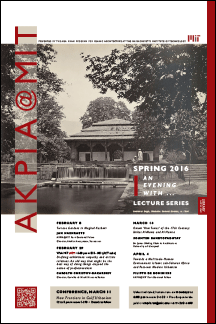Lectures, Conferences & Events» Past Lectures & Events
Soumyen Bandyopadhyay
Omani "New Towns" of the 17th Century: Birkat Al-Mawz and Al-Hamra
Abstract
This talk will focus on two oasis settlements (Birkat Al-Mawz and Al-Hamra) developed through collaboration between the Ya'aribah imamate and newly formed tribal confederations (Bani Riyam and 'Abriyeen) and introduced a new set of intermediate settlements between the isolated mountain villages and the large oasis towns of the plains. Both settlements are the product of new water harnessing systems (aflaj – qanat in Persia), which the Ya'aribah help develop. The settlement leadership experience different fortune as they enter the twentieth century.
Carolyn Christov-Bakargiev
Drafting exhibitions: empathy and artistic relations. An old way that might be the best way of doing things – beyond the notion of professionalism
Biography
Carolyn Christov-Bakargiev is an author, an organizer of events and exhibitions, and a researcher of artistic practices, the histories of art and the politics of aesthetics. She is the Edith Kreeger Wolf Distinguished Visiting Professor in Art Theory and Practice at Northwestern University (2013–15), Getty Visiting Scholar (2015) and incoming Director as of 2016 of the Castello di Rivoli Museum of Contemporary Art and GAM / Galleria Civica d’Arte Moderna and the in Turin, Italy. She drafted the 14th edition of the Istanbul Biennial in 2015 (SALTWATER: A Theory of Thought Forms) and was the artistic director of dOCUMENTA (13) which took place in 2012 in Kassel, Germany as well as in Kabul, Afghanistan; Alexandria and Cairo, Egypt; and Banff, Canada. Previously, she was the artistic director of the 16th Biennale of Sydney, Revolutions—Forms That Turn (2008); and senior curator at P.S.1 Contemporary Art Center, a MoMA affiliate in New York, from 1999 to 2001.
Filippo De Dominicis
Towards a Multiscale Human Environment: Islamic sub-Saharan Africa and Post-war Modern Urbanism
Abstract
In 1958, 1962 and 1968, C.A. Doxiadis, G. Candilis (with A. Josic and S. Woods) and M. Ecochard drafted three urban schemes for Khartoum (Sudan), Fort-Lamy (Chad) and Dakar (Senegal), experimenting new positions in Modern urban planning and trying to go beyond the CIAM discourses on urbanism. These plans share similar historical circumstances and geographical conditions, as Dakar, Fort-Lamy and Khartoum lie across the southern Saharan frontier, along the northern boundary of the tropical zone. Developed in the African postcolonial transition (1958-1968) these plans were prepared by three architects who were familiar with the Islamic urban environment, having worked, even collaborating together, in several projects in Pakistan, Iraq and Morocco. Plans and planners could therefore be inscribed in the post-war debate over Modernist urban design, influenced as it was by the local context and cultural milieu. Plans for Dakar, Fort-Lamy and Khartoum are different expressions of a larger, Pan-African planning idea that prevailed in the early decolonization period. In other words, these three plans bridge the gap between the indigenous dwelling culture (deeply influenced by Islamic culture) and the issues posed by the new Pan-African discourse. Focusing on these three plans, I will consider the role and nature of the pre-existing Islamic environment, vis-à-vis the cultural background and political ambitions expressed by these three architects and by the new leaders in Africa. The key question is: Can we consider the Islamic sub-Saharan urban environment as a testing ground for new directions in post-war global urban-design theories?
Biography
Filippo (Rome, 1982), studied Architecture in Brussels and Rome. He holds a PhD in Architectural Design and Theory from Sapienza University of Rome (2012) and a MArch from the same University (2008). After a two-years post-doctoral fellowship at IUAV University of Venice (scientific supervisor prof. Benno Albrecht), he is currently post-doctoral fellow at the Aga Khan Program for Islamic Architecture, Massachusetts Institute of Technology. His research at MIT investigates the relationship between the sub-Saharan environment and the multiscale planning process established by the most prominent Panafrican leaders. Filippo’s current research topic arises from a two-years study of the traditional sub-Saharan environment, with a special focus on the ecological mechanisms set up along the southern border of the Great Desert.
Jan Haenraets
Terrace Gardens in Mughal Kashmir
Abstract
The seventeenth century Mughal gardens of Indian-administered Vale of Kashmir are an exceptional testimony of the creative and innovative ingenuity demonstrated by the Mughals in taking maximum advantage of the natural settings for garden-making. It is said that several hundreds of Mughal gardens were created in Kashmir but since the decline of the Mughal Empire most of these sites suffered neglect, with only a handful of well-known sites now developed as popular visitor destinations.
The talk will look at where these Mughal gardens would have been located and investigates the typology of Mughal gardens in Kashmir. The significant evolution of the terrace garden typology in Kashmir is examined through comparing different approaches to modular planning within the topographical context of this Himalayan region.
Biography
Jan is a Director of Atelier Anonymous Landscape Consultancy Inc., Vancouver, BC, and the Atelier Anonymous Global Landscape Foundation, which purpose is to globally support, preserve and promote landscape heritage sustainability projects. He is a Landscape Architect, preservation and heritage expert, and environmental advisor with an expertise in multidisciplinary and global heritage management and preservation approaches.
He was Head of Gardens and Designed Landscapes of the National Trust for Scotland and Assistant Professor in South Korea. He is an Advisor to the Indian National Trust for Art and Cultural Heritage, Jammu and Kashmir Chapter, where he assists with cultural landscape and heritage advice, and supports the conservation of the Mughal gardens and their UNESCO World Heritage nomination. Jan co-authored several cultural landscape management reports with the Olmsted Centre for Landscape Preservation, US National Park Service. He obtained his M.A. in Conservation Studies at the University of York and a Ph.D. in Landscape Conservation at De Montfort University, UK, researching the challenges with preserving designed landscapes and heritage from the twentieth century. He is a member of the DOCOMOMO International Specialist Committee on Urbanism and Landscape.
